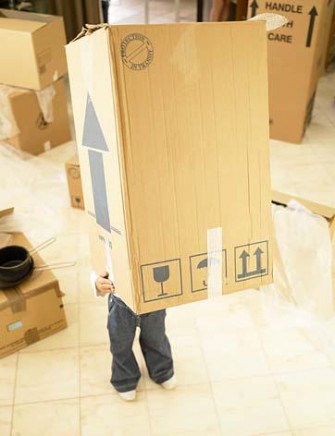Before, During and After: Tips for a Kid-Friendly Move
 Moving can be stressful enough for adults, let alone children. Studies have shown that children who move frequently tend to do poorly in school and have more behavioral problems. The study also found that introverted people who moved often when they were young demonstrated less well-being as adults — and even died younger — because they had fewer close social relationships. However, if you do the right things, most kids are going to handle it fairly well. First, take a deep breath and relax: The vast majority of kids who move, especially if it’s under three or four times [in their childhood], do well. There’s no single, telltale sign that your child might be having trouble with an upcoming or recent move, psychologists say. Instead, parents should look for sudden, unusual changes from normal behavior such as:
Moving can be stressful enough for adults, let alone children. Studies have shown that children who move frequently tend to do poorly in school and have more behavioral problems. The study also found that introverted people who moved often when they were young demonstrated less well-being as adults — and even died younger — because they had fewer close social relationships. However, if you do the right things, most kids are going to handle it fairly well. First, take a deep breath and relax: The vast majority of kids who move, especially if it’s under three or four times [in their childhood], do well. There’s no single, telltale sign that your child might be having trouble with an upcoming or recent move, psychologists say. Instead, parents should look for sudden, unusual changes from normal behavior such as:
- Tantrums
- Varying degrees of sadness
- Isolation
- Picking fights with siblings or good friends
- Defiance toward parents or teachers
- Academic difficulties where none existed previously
Before the Move
Be Happy!
A parent who is not excited about moving — or who is negative or ignores the child — can give off a negative vibe about what’s coming. Being excited about the move or treating it like an adventure goes a long way
Talk it Out
Have your child list questions or fears about the upcoming move. Then, gather as a family so you, the parent, can address those questions.
Make the New Familiar
As soon as you can before a move, help your children become familiar with their new home so they can visualize it, experts say:If your new town or home is close enough, take your kids on a tour. Have them meet coaches and teachers. Let them see their future bedroom in person.
During the Move
Keep Track of Personal Belongings
Possessions help anchor children and make them feel comfortable. During a move, they might worry that the items will be lost. Help children pack their possessions in boxes that will be easy to find, and write your address on the boxes, so your kids learn it. Choose a few of the most important items to make the car or plane trek to the new home.
Give them Some Control
Let your children have a strong voice in what their new bedrooms look like: who gets what space, where the furniture will go and what color the walls will be.Make the new room more exciting than the old room. Whatever little thing you can do to make your child happy in a new place is really important.
After the Move
Make a Map
Once you are established in the new neighborhood, get a sheet of poster board and have younger kids make a map of where everything is located — home, school, soccer fields — so that they feel more at home in the neighborhood and don’t feel they will get lost, which is often a fear when moving,
Keep Old Ties Intact
For kids, it’s tough to leave old friends. These days, however, it’s easier than ever for your child to stay in touch with friends in the former town or neighborhood — be it via email, Skype, phone or Facebook. Encourage them to stay in touch, and if they are young, help them do so.
Get Them Involved
Once you’ve moved, enroll your children in a class or a club that interests them — karate or swim team, for example. Immerse the kid in some activity in the new neighborhood, and don’t just rely on the fact that they’ll make friends in school. Unless they are advanced at the activity, enroll them in an introductory course, so they can feel on par with everyone else, and not behind.
With a little luck, the biggest concern about your move will be whether your mail has made the switch with you.
